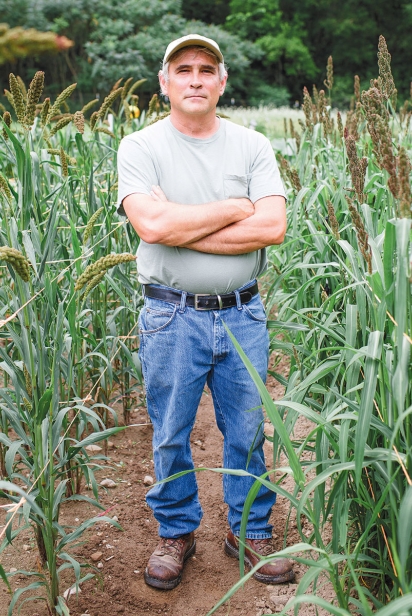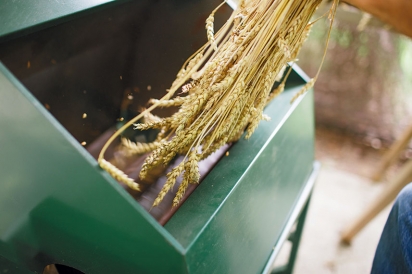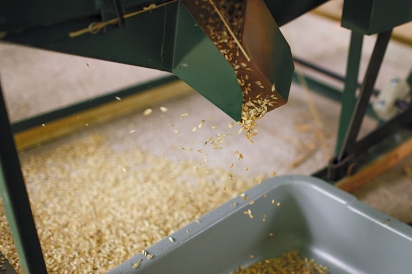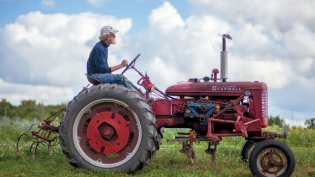Back to the Future: John Sherck
John Sherck’s passion for heirloom fruits and vegetables started over 20 years ago with a single bite of a Black Crim—a variety of heirloom tomato with genetic origins in the Crimean region of the Ukraine.
“I got excited because it wasn’t a newly created crop—it had a historical aspect to it,” Sherk says. “It’s exciting to think that many heirlooms came through Ellis Island in the pockets of immigrants.”
Heirloom crops, typically defined as plants cultivated prior to modern industrial agriculture, are the result of multiple generations of gardeners saving their harvested seeds. Sherck raises these plants mostly for experimentation, preserving an age-old tradition.
Today, over 90% of his crops are heirlooms. And while Sherck’s fascination with heirloom varieties is reflected in the diversity of his fields, the methods he uses on his half-acre farm in Bristol, Indiana, also preserve a nearly forgotten farming technique.
Farming the Old-Time Way
“You can create new varieties, or you can breed new varieties,” Sherck explains. While modern technology enables genetically engineered produce, Sherck’s style of farming uses the age-old techniques of selection and cross-pollination to breed new varieties of plants that adapt to changing conditions with each new generation on the farm.
Seeds from plants that perform well, resist disease and have a high yield are saved and sown in the next growing season. As plants become acclimated to Northern Indiana’s weather patterns, Sherck collects seeds for both long-term storage and interested customers.
The primary obstacle to such acclimation is time. It often takes at least five years to stabilize a new variety of tomato by cross-pollinating two parent varieties.
Prior to the 1940s, Sherck says, there was less reliance on modern technology or hybridizing crops and most farmers saved their own seeds. Like Sherck’s farm, most in that era would have had a very diverse crop production on a small plot of land.
Sherck cultivates leafy greens, medicinal and culinary herbs, perennial vegetables, melons and other heirloom alternatives to traditional produce. But he is especially enthusiastic about what he calls “staple foods,” like beans and grains, which play important roles in most people’s diets.
When Sherck’s customers are interested in purchasing seeds for corn, cucumbers or tomatoes for their home gardens, he urges them to consider wheat, barley or oats, too.
Grains such as wheat, he believes, are particularly important for gardeners interested in greater self-sufficiency: On about 1,000 square feet, Sherck explains, a gardener could harvest almost 50 pounds of wheat in one season, enough to make about 50 loaves of bread. Sherck recently harvested nine varieties of barley, as well as oats, flax, sesame and quinoa. He grows three varieties of soybeans, five varieties of beans and peanuts, as well as sorghum, rice, millet, rye and corn—all with origins from across the globe. Barely any tillable soil is left untouched on his farm.
And whenever he finds bare soil, Sherck keeps a bag of buckwheat handy at all times. Planting buckwheat not only yields a useful crop, but also attracts beneficial insects while preventing erosion.
Preserving Tradition, Preserving Technology
In the process of preserving this style of farming, Sherck often seeks what he refers to as “third-world technology”: farming and food processing equipment that, while considered obsolete in “developed” nations, would be ideal for small-scale farmers.
Sherck purchased an old-fashioned treadle-powered grain crusher made with modern materials, plus a hand-crank oil press and a nonelectric rice de-huller from a producer in Delaware, modeled after a de-huller he was only able to find in Southeast Asia.
“That’s the only small-scale hand-powered rice de-huller in the United States,” he says, adding that it was built by hand in someone’s basement. Finding these machines within the States is difficult, but they help Sherck significantly.
“I think technology has important roles,” Sherck says, “but the problem is that for some people it’s one or the other.” While there are a minority of people who may shun modern agricultural technology completely, others rely entirely upon it—particularly via genetically modifying plants to grow in a specific way or resist certain hazards, Sherck explains.
And while genetically engineered crops may be seen by many as the future of agriculture, Sherck believes they only create new problems that will demand further engineering. “If genetic engineering is the reliance we have for the future,” he says, “it’s something that only a corporation can do.”
“That’s the only small-scale hand-powered rice de-huller in the United States,” he says, adding that it was built by hand in someone’s basement. Finding these machines within the States is difficult, but they help Sherck significantly.
“I think technology has important roles,” Sherck says, “but the problem is that for some people it’s one or the other.” While there are a minority of people who may shun modern agricultural technology completely, others rely entirely upon it—particularly via genetically modifying plants to grow in a specific way or resist certain hazards, Sherck explains.
And while genetically engineered crops may be seen by many as the future of agriculture, Sherck believes they only create new problems that will demand further engineering. “If genetic engineering is the reliance we have for the future,” he says, “it’s something that only a corporation can do.”
Sherck finds that his old-fashioned agriculture system enables better decision making—especially on a small farm, where all harvesting is done by hand. Sherck, who has no employees, tends to his farm almost entirely by himself. His wife, Suzanne, often helps.
“It’s a low-tech approach, a lot of handwork, and very physical,” Sherck says, “but for me, the point is learning to do it yourself.”
John Sherk’s seeds can be purchased at his roadside stand, located at 56549 SR 15 in Bristol, Indiana, or online at SherckSeeds.com.









